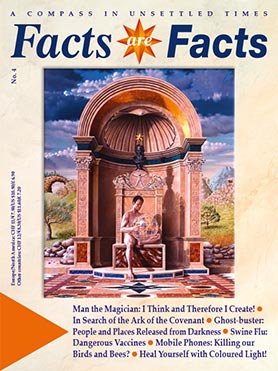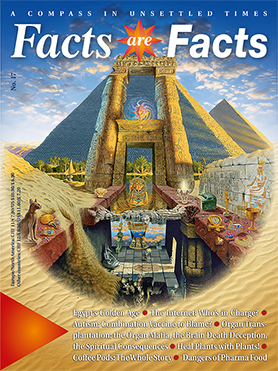The Ark of the Covenant instead of the Holy Grail?
What is it about the mysterious Rennes-le-Château in Southern France? Thomas Ritter ventured out in search of clues and stumbled across untold wealth, the possible hiding place of the Ark of the Covenant, and a Jewish king who appears to be the ancestor of all the European royal houses.
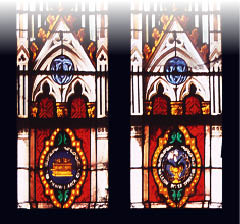
The stained glass windows at the church in Limoux (located 24 kilometers from Rennes-le-Château) depict the Ark of the Covenant and the Holy Grail!
It is the history of this place that gives Rennes-le-Château its peculiar appeal. Strange things happened in this village over one hundred years ago, which until then had been lost to the world. It all began around 1900 when a country priest, Bérenger Saunière, mysteriously came into untold wealth. Shortly thereafter, he built Villa Bethania and the neo-Gothic tower he named after Maria Magdalena. Here he stored his personal library and renovated the local parish church at his own expense, but how did Saunière suddenly acquire such a fortune? Was he an alchemist in league with the Devil like the village inhabitants still believe to this day? Why did the Vatican pay him vast sums of money afterward? Did Saunière discover a treasure such as the legacy of the Visigoths or the Knights Templar?
Saunière’s fantastical wealth seems to have originated from a treasure trove, a notion substantiated by the rich antiques he gave as gifts to some of his colleagues in the area. For example, the priest Grassaud received an extremely old and richly decorated chalice and Abbé Courtaulay from Couiza was given a considerable quantity of 6th and 7th century coins. Saunière was lavishly funded by other sources as well. He received payments from the royal houses of Chambord and Habsburg and his colleague Henri Boudet from neighboring Rennes-les-Bains transferred millions to Saunière in Rennes-le-Château and even to his superior, Bishop Billard, in Carcassonne. Saunière received high-profile guests such as the cousin of Austrian king Johann Salvator von Habsburg, the French education minister, and the famous opera singer and his supposed mistress, Emma Calvé.
Despite the death in 1914 of Saunière’s father-like friend and mentor, Boudet, he did not give up on his projects, which were constantly increasing in size. As World War I rampaged across Europe, Saunière planned to cover the entire village of Rennes-le-Château with a temple canopy more than fifty meters high, supported by nine columns and surrounded by a wall. Saunière’s architect, Elias Both, made an initial cost estimate of eight million francs (about 120 million Euros) for the structure, but the priest suffered a sudden stroke on January 17, 1917 and died five days later.
The Visigoth Treasure?
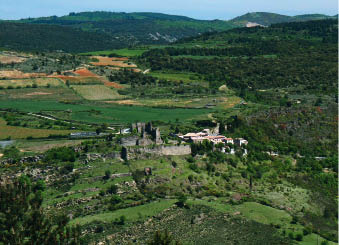
The otherwise insignificant town of Rennes-le-Château was visited by French presidents Mitterrand and Chirac shortly after they took office.
The Arch of Titus in Rome still shows how the Temple treasure with the large menorah—a seven-armed candelabrum made of pure gold—was once carried along in Titus’ triumphal procession with the Rainbow of the Covenant and the emerald tablets bearing the Old Testament Commandments—which is exactly what Procopius tells us the Visigoths had looted and added to their spoils of war. The Visigoths possessed a treasury that other nations could only dream of: “The Visigoths were renowned for having the richest hoard of gold and their chapels possessed much more precious cultic vessels than other churches.” There were two very special pieces of art that were part of this treasure—the Missorium and the Emerald Tablet. The Missorium was a vessel of solid gold adorned with jewels. The Emerald Tablet, although probably not crafted with emeralds, made such an impression upon people that it comes up time and again in different stories. The whereabouts of both pieces are unknown today.
The glamorous times of the Visigoths came to an end in 507 AD when they were eradicated by King Chlodwig and the Merovingians in the battle of Vouillé. Alarich II lost the battle along with his kingdom and his life. The Visigoth capital Toulouse was conquered and plundered by the progressing Merovingian armies only to be stopped before the walls of heavily fortified Carcassonne. Chlodwig fought hard to conquer Carcassonne because it protected the “holy” Visigoth treasure including the Missorium and Emerald Tablet. According to the writings of Procopius of Cesarea, Chlodwig began with the siege of Carcassonne, “because he knew exactly that the holy treasure was being kept there… the treasure that Alarich looted in earlier times when he conquered Rome.” Yet the Visigoths managed to hold Carcassonne, forcing Chlodwig to eventually halt the siege and withdraw.
Procopius goes on to report that the Visigoth General Ibbas “gathered all of the treasures stored in the city of Carcasonne and marched them to Ravenna” after the siege had ended. According to Procopius, at least a portion of the treasure stored at Carcassonne was also brought to Rhedae because it was much more defensible than Carcassonne, which had become a border-town of the dwindling Visigoth territory at that point.
In the centuries to follow, the Visigoth Empire gradually shrunk to a minute area (known today as the Razès) due to ongoing assaults from its enemies, especially the Franks.
It is apparent that the new Visigoth capital Rhedae remained unchallenged by Frankish offensives. In a consensus report from Bishop Theodulf to Charlemagne ranking the most important southern cities, Rhedae was equated to cities such as Carcassonne or Narbonne.
In the final times of the Visigoth Empire, the old and holy treasure was supposedly hidden in twelve different places in what is now Rennes-le-Château. French historian Tatjana Kletzky-Pradere came to this conclusion through her research. Among other clues, she came across the strange notes from Abbé Henri Boudet, the clergyman from Rennes-les-Bains who had a very close relationship with Bérenger Saunière.
The inconspicuous and feeble-looking Abbé Boudet is surely a key figure in the puzzle surrounding Rennes-le-Château. Starting in 1872 he worked as a priest in the wealthy spa village of Rennes-les-Bains. Although he came from humble origins, Boudet was highly educated and had an extensive knowledge of ancient languages and archeology. In his youth and during his education in Carcassonne, one of Henri Boudet’s teachers was the priest Emile-François Cayron, who was one of the insiders privy to the secrets of Rennes-le-Château. It is through him that Boudet became acquainted with the family tradition of the counts of Hautpoul de Blanchefort. To this secret he dedicated his studies in the mountains and valleys around Rennes-les-Bains where he often took long hikes. It is with absolute certainty that we know Henri Boudet was the true “rediscoverer” of the Rennes-le-Château treasure. He published a book in 1886 with the strange title La vraie Langue Celtique et le Cromleck de Rennes-le-Bains (The True Celtic Language and the Stone Circle of Rennes-les-Bains), of which 800 copies circulated. Shortly after it appeared, the book received ruinous criticism in professional circles; scientists labeled it an “unserious and hilarious script.” Critics accused the writer-priest of “having primarily quoted other writers”—Henri Boudet had simply copied the works of various other authors.
Many treasure hunters, but also renowned historians, are of the opinion that Boudet’s book contains the encoded key to the mysterious Hautpoul de Blanchefort family secrets. After all, Abbé Boudet declares the purpose of his publication right from the start in the preface: “To penetrate the secret of a local story by interpreting a name composed in a foreign tongue…”
Kletzky-Pradere believes that this is a clue to a cryptic code without which the contents of the book will remain incomprehensible and confusing. On page 126 of his book, Boudet proudly announces that he would speak in a certain jargon because of outsiders and on page 11 he gives some very interesting clues about the possible key. Numerous researchers have studied La vraie Lange Celtique over and over again in recent years hoping to reveal the secret locked inside Boudet’s work. They thought that Boudet had recorded the coordinates of twelve hiding places around Rennes-les-Bains and Rennes-le-Château, which house the treasure legacy of the Visigoths.
In Search of Clues
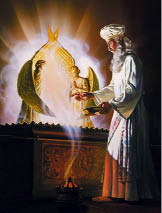
The Jewish high priest conjures the Jewish god during Purim Festival—at the risk of his life.
What I had found was a lead seal used in the Dark Ages for sealing vessels that protected and transported important documents. The lead seal is attributable to the Visigoth era. In addition, I found two coins—one copper, the other silver. The copper coin was clearly of Roman origin and stamped during the time of Constantine the Great (306 - 337). The patina-coated silver piece was a Hebrew coin and, according to my contacts at the Bavarian National Coin Collection (Staatliche Bayrische Münzsammlung) in Munich, could very well have been in circulation around the time Christ was born.
If we are to rule out the unlikely possibility that these coins were brought here in modern times, then we have a significant piece of evidence. The Hebrew coin is a sign of Solomon’s temple treasure that Titus brought back to Rome after he conquered Jerusalem in 70 AD. The Roman copper coin and the Visigoth lead seal indicate that the treasures hidden on Mount Sebairous are at least part of the legendary Visigoth treasure, which may contain not only valuables but also explosive documents.
This evidence seems to confirm Tatjana Kletzky-Pradere’s hypothesis of twelve treasure troves surrounding Rennes-le-Château. Since Bérenger Saunière found and plundered only a few of these hiding places at the most, there is a real possibility that the Missorium and the Emerald Tablet are still to be found somewhere around Rennes-le-Château. Such unique treasures might explain why the Habsburg family and the Vatican so generously financed Bérenger Saunière.
In September 2008 and March 2009, extensive geophysical investigations of the area around Rennes-le-Château took place in conjunction with scientists from the University of Göttingen, Germany. Using seven different methods of measurement in direct proximity to the village and near the source of the Sal River, they discovered subterranean, man-made caverns. The coordinates of these locations were determined using GPS and can be reproduced at any time. These are possibly additional storage places for the fabled Visigoth treasure.
Yet Abbé Saunière’s knowledge could even be connected to much more than just the village; the written records of historical witnesses recount that Saunière occasionally left Rennes-le-Château. French researcher André Douzet was successful in compiling evidence that Abbé Saunière occasionally stayed in Lyon. He even managed to find the address of the priest at that time in Rue des Maccabées (Maccabee Street), famous for its goldsmithing and located in the former Jewish quarter. This was quite a strange place for a Catholic priest. Obviously, Bérenger Saunière led a double life. While in Lyon, André Douzet discovered that Saunière maintained contact with the Martinist Order, an esoteric association with Jewish origins whose members included such charismatic figures as Dr. Gerard Encausse, called Papus, and his mentor Philipp de Lyon, a spiritual master and healer. Papus and Philipp maintained close ties with the Russian Czar’s court and were confidants of the Romanovs; they openly declared themselves opponents of the itinerant preacher Rasputin.
Sources
- 1Cromlech (kelt. crom, “curved”, and lech, “stone”); stone circle, ring-shaped stone settings, formed of upright-standing, unhewn stones.





